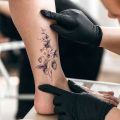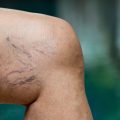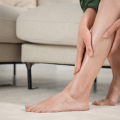Search a topic
Last updated on April 22, 2024
Spider veins don’t usually cause discomfort or pose a threat to your health. However, many seek out ways to eliminate them because of their branching or web-like appearance. So, how do you get rid of spider veins? Let’s get into the effectiveness of medical treatments and home remedies for the condition.
Professional treatment
There are many professional spider vein treatments that reduce the veins’ appearance or get rid of them entirely. These include:
Sclerotherapy
Sclerotherapy involves injecting a sclerosant into the spider vein to seal it shut. Once blood stops flowing through the vein, your body will start absorbing it, and you’ll see the vein gradually disappear. For the best results, you may need 2-3 treatments.
There are a few types of sclerosant solutions specialists typically use to get the job done:
- Polidocanol
- sodium tetradecyl sulfate
- hypertonic saline solutions
- Dextrose
- Aethoxysclerol
These solutions damage the vessel, causing the blood to coagulate and seal the vein as an anti-inflammatory response.
Closure system therapy
This method of spider vein treatment also involves injecting a solution into the vein. But unlike sclerotherapy, CST uses a sticky substance to glue the walls of the vein together, sealing the vessel shut.
EVLT: laser treatment for spider veins
Endovenous Laser Treatment (also known as Endovenous Laser Ablation, or EVLA) involves inserting a laser fibre into the vein, heating it, and sealing it shut. This treatment works best for large spider veins. It can’t be used on smaller ones that cannot fit the fibre.
Transdermal laser: Nd:YAG
Nd:YAG is a non-invasive treatment designed to clot and dry spider veins through heat energy. It is most effective for smaller spider veins near the surface of the skin.
Veinwave or Thermocoagulation
Thermocoagulation works similarly to EVLT. Here, the practitioner uses the VeinWave technology to heat the vein, getting it to constrict. They do so through ultra-fine needles that pierce the surface of the skin and make contact with the spider vein.
Combination (CLaCS)
The CLaCS (Cryo Laser and Cryo Sclerotherapy) method combines traditional sclerotherapy injections with a transdermal laser. We first use the laser to seal tiny spider veins near the skin surface and shrink those in lower layers. For these larger, deeper veins, we then inject Dextrose or Aethoxysclerol solution.
During the procedure, we will also use a deep cooling system to numb your skin to the sensation of laser heat.
Home remedies
Home remedies have yet to be proven to treat spider veins in the way that professional treatment can. However, some remedies can reduce the appearance of existing spider veins and stop new ones from forming.
Common examples of home remedies include:
- Compression: compression socks help veins do their jobs. These garments squeeze blood out of congested surface veins into the deep veins and stimulate the muscle to help the deep veins move it up to the heart. While compression improves vein function, it sadly doesn’t reverse the effects of faulty valves or burst veins.
- Blue light therapy: commonly used to treat skin conditions like acne, blue light therapy hasn’t yet been proven effective for treating spider veins. However, some claim the treatment has shrunk their veins.
- Topical creams. Creams using Vitamin K, Retinol, Horse Chestnut, Butcher’s Broom, or some combination of the above can temporarily reduce the appearance of spider veins via their anti-inflammatory and skin-tightening properties.
Get rid of your spider veins
In short, to eliminate your spider veins, it’s best to seek out professional treatments like CLaCS. While the spider veins aren’t likely to vanish immediately, treatment will provide a long-term solution. While home remedies can be effective in some cases, their effects are only temporary.
If you’d like to get rid of your spider veins, give us a call at 0483948908 and book your consultation.





